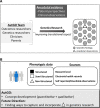The AutGO Initiative: A Conceptual Framework for Developing Genetics-Outcomes Research Hypotheses
- PMID: 32618145
- PMCID: PMC7496490
- DOI: 10.1002/aur.2331
The AutGO Initiative: A Conceptual Framework for Developing Genetics-Outcomes Research Hypotheses
Abstract
The increasing emphasis on translational approaches to complex neuropsychiatric and neurodevelopmental conditions research requires scientists from a broad range of disciplines to build dynamic collaborations when formulating hypotheses and framing study designs. The need to integrate the knowledge and perspectives not only from multiple scientific silos but also from the populations impacted by these conditions presents a significant challenge to researchers, particularly for a heterogeneous condition like autism. As one path toward addressing these challenges, we have previously introduced Autism Genetics Outcomes (AutGO), an initiative to support broad stakeholder partnerships and promote a new integrated concept called GO (i.e., research approaches that draw on both genetics and clinical outcomes perspectives). Herein, we developed a workflow for collecting stakeholders' feedback toward the development of a GO hypothesis. AutGO is an evolving initiative, and here we describe how its three essential components (conceptual framework, applicability, and implementation) have been developed. As a proof-of-concept, the AutGO team sought to demonstrate how a GO hypothesis could be developed using a semi-structured literature review workflow. We also developed a prototype from published reports and formulated a GO hypothesis for autism. Rather than seeking community stakeholder input after a research project is conceptualized and designed, the developed conceptual framework demonstrates the feasibility of formulating scientific hypotheses by engaging stakeholders in retrospective semi-structured literature reviews. The presented workflow, prototype, and discussed recommendations will bring awareness in the autism research community about the benefits of applying the GO approach in order to promote translational aspects in genetics research. LAY SUMMARY: We used a community-based engagement approach to develop AutGO (Autism Genetics Outcomes), an initiative to establish stakeholder partnerships and to promote research approaches (we refer to as GO) that draw on both genetics and clinical outcomes perspectives. Specifically, we developed a conceptual framework that includes a literature review process for developing GO hypotheses and stakeholder feedback collection protocol. Our work will bring awareness in the autism research community about the benefits of integrating patient perspectives in genetics research. Autism Res 2020, 13: 1286-1299. © 2020 The Authors. Autism Research published by International Society for Autism Research published by Wiley Periodicals LLC.
Keywords: autism; conceptual framework; genetics; engagement; outcomes; stakeholders; translational research.
© 2020 The Authors. Autism Research published by International Society for Autism Research published by Wiley Periodicals LLC.
Conflict of interest statement
ZT, AS, and AutGO Working Group members (DS, CB, DB, SB, JB, ABE, AB, BC, MDG, MAH, VH, MI, MK, AK, KL, MM, JM, JJM, MM, CN, GN, BS, KS, MS, CS, HS, OJV, and DW) declare that they have no conflict of interest and/or nonfinancial conflicts.
Figures




References
-
- Bolte, E. R. (1998). Autism and Clostridium tetani. Medical Hypotheses, 51(2), 133–144. - PubMed
-
- Bolte, E. R. (2003). The role of cellular secretion in autism spectrum disorders: A unifying hypothesis. Medical Hypotheses, 60(1), 119–122. - PubMed
-
- Buie, T. , Campbell, D. B. , Fuchs, G. J., 3rd , Furuta, G. T. , Levy, J. , Vandewater, J. , … Winter, H. (2010). Evaluation, diagnosis, and treatment of gastrointestinal disorders in individuals with ASDs: A consensus report. Pediatrics, 125(Suppl. 1), S1–S18. - PubMed
Publication types
MeSH terms
LinkOut - more resources
Full Text Sources
Medical
Research Materials

